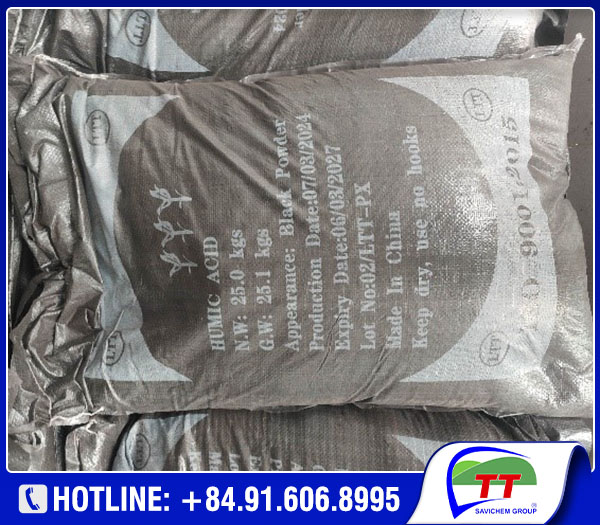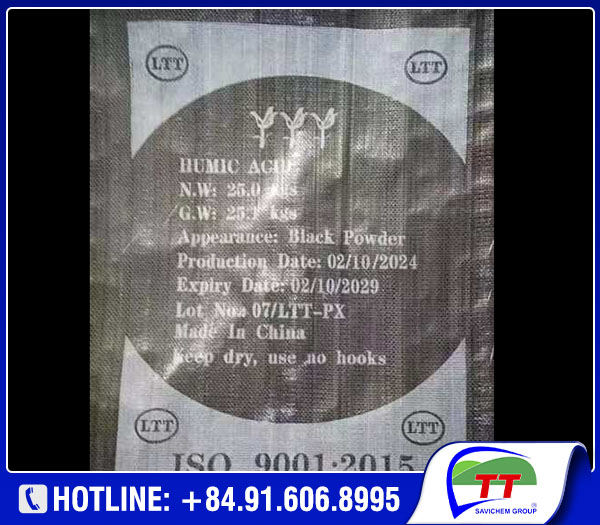HUMIC ACID – AN ESSENTIAL COMPONENT OF ORGANIC MATTER IN SOIL
Introduction to Humic Acid
Humic Acid is a vital component of organic matter in soil, formed through the accumulation and incomplete decomposition of plant residues under anaerobic conditions. The content of Humic Acid in soil depends on geological characteristics, vegetation, and the duration of decomposition. It is one of the three main components of organic humus compounds in soil, alongside Fulvic Acid and Humin.
1. Product Information
Humic Acid primarily contains the following elements: C, H, O, and N. The content of these elements varies depending on soil type, the chemical composition of organic residues, and humification conditions:
- C: 56.2% – 61.9%
- H: 3.4% – 4.8%
- O: 29.5% – 34.8%
- N: 3.5% – 4.7%
Humic Acid has a complex network structure, with each network consisting of many simple structural units formed during decomposition. It is soluble in dilute alkaline solutions like NaOH, Na2CO3, and Na4P2O7·10H2O, with the resulting solution ranging in color from cherry to black, depending on concentration and soil type. However, Humic Acid is insoluble in water and inorganic acids. Salts of Humic Acid dissolve completely in water, producing a yellow-brown to dark brown solution.
2. Applications of Humic Acid
Humic Acid is widely used in soil improvement and enhancing crop quality:
- Soil Remediation: Improves the fertility of poor soils and enhances soil productivity.
- Fertilizer Efficiency: Increases the effectiveness of fertilizers and minimizes nutrient loss due to runoff.
- Plant Resilience: Aids plants in resisting adverse conditions such as drought, low temperatures, diseases, and pests.
- Growth Stimulation: Stimulates physiological activity and development in crops, leading to increased yield and quality of agricultural -products.
- Microbial Activity: Promotes beneficial microbial activity, reduces salinity levels in saline soils, and helps adjust soil pH.
- Oxidative Resistance: Enhances antioxidant capacity, stimulates plant enzyme activity, and improves seed germination rates.
- Salinity Reduction: Helps mitigate excessive salinity in soil and improves soil water retention.
3. Usage and Storage Guidelines
❖ Usage:
Humic Acid can be used directly as a supplement alongside manure to create organic fertilizers or as an ingredient in organic fertilizer products. It can be mixed with KOH solution to produce Potassium Humate for application to crops. Application methods may include soil application, drip irrigation, or foliar spraying.
❖ Storage:
Humic Acid should be stored in a cool, dry place, away from direct sunlight.
4. Ly Truong Thanh – A Trusted National Distributor of Humic Acid
Established in 2010, Ly Truong Thanh Co., Ltd. specializes in the import and distribution of products across various sectors, including animal feed ingredients, food additives, fertilizer raw materials, and basic chemicals.
Our key products include Calcium Chloride, Sodium Bicarbonate, Cyanuric Acid, Sodium Humic Acid, Humic Acid, Potassium Humate, Fulvic Acid, Lecithin, Choline Chloride, Wheat Gluten, and many others.
We import from countries such as Japan, South Korea, China, Thailand, Malaysia, Indonesia, Singapore, Brazil, and India, distributing widely throughout Vietnam, Laos, and Cambodia. All products undergo rigorous quality testing by reputable inspection centers like Quatest 3, Vinacontrol, and SGS Vietnam Ltd.
Contact Ly Truong Thanh today for consultation and to procure high-quality Humic Acid products!




